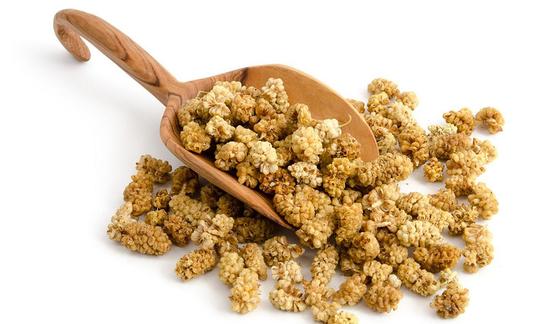Table of contents
Dried mulberries ( organic ) are not as colorful and tasty as fresh mulberries, but they are transportable and have a long shelf life. They are mainly produced from the raw berries of the white mulberry ( Morus alba ), less often the black mulberry ( Morus nigra ).
Use in the kitchen
Gently dried organic mulberries are still raw food quality. Fresh mulberries lose some of their color when dried. The dried berries are very firm and have a rough outer shell; their taste is similar to raisins .
You can eat the dried fruit on its own, like cranberries , goji berries and sour cherries . Dried mulberries are an ideal topping for muesli (e.g. in pea muesli ), porridge or smoothie bowls. It is important not to eat too many berries at once, as they contain a lot of calories and sugar.
You can easily make jam from the berries if you don't have access to fresh mulberries. To do this, soak the berries in water for about 4 hours, chop them up with a hand blender, boil the mixture for a few minutes and fill the jam into jars. The jam made from the dried berries can be refined with vanilla, cinnamon , lemon or orange peel . Dried mulberries also taste good in vegan baked goods such as cakes , cookies and fruit bread.
Making your own dried mulberries
First, wash the fresh organic mulberries and dry them with a kitchen paper towel. Then place them in the dehydrator or on a baking tray lined with baking paper.
To maintain raw food quality, the raw mulberries should be dried gently. Valuable nutrients are lost at high temperatures. This is why dehydrators are particularly suitable, as you can set them to 42 °C. When drying in the oven, you should choose the lowest setting (usually 50 °C) and tilt the oven door slightly so that the moisture can escape. The best way to do this is to wedge a wooden spoon in the door.
Sun drying can be done outdoors on an air-permeable surface such as gauze or cotton muslin. However, this can result in the temperature restrictions of 42 or 45 °C for "real" raw food being exceeded.
Vegan recipe for oatmeal porridge with dried mulberries
Ingredients (for 1-2 people): 1 cup oatmeal , 1/2 cup dried mulberries, 1 cup water , 1 cup plant-based drink ( almond milk , soy milk or similar), 1 apple .
Preparation: Put the oat flakes, mulberries, water and plant-based drink in a pot. Let the porridge simmer gently over medium heat for three to five minutes. Wash the apple, remove the core and cut into thin slices. Put the porridge in one or more bowls and garnish with apple slices.
Tea preparation
For 1 litre of tea, take a handful of dried mulberries and pour boiling water over them. After ten minutes of steeping, pour the tea into cups. The dried fruits make the tea pleasantly sweet, so it is a refreshing drink even in summer when served ice cold.
Tea made from dried mulberry leaves is reminiscent of green tea in color and taste.
Vegan recipes with dried mulberries can be found under the note: " Recipes that have the most of this ingredient ".
| Not only vegans or vegetarians should read this: Vegans often eat unhealthily. Avoidable nutritional mistakes . |
Purchasing - Storage
Dried mulberries (black and white) can be found at major retailers such as Coop , Migros , Spar and Rewe , some of them also in organic quality. Denner , Volg , Aldi , Lidl , Edeka , Hofer and Billa do not have mulberries in their standard range. Dried organic mulberries can also be bought in health food stores and online shops and occasionally in organic supermarkets such as Denn's Biomarkt and Alnatura .
The term "raw food" is not regulated by law, which is why there are no state certification bodies for it - unlike organic production. You have to be careful with the terms "raw" or "sun-dried" because producers do not always adhere to the temperature restrictions (approx. 42 to 45 °C for "real" raw food) precisely. Conscious consumers also prefer non-sulphured dried wolfberries (unsweetened). Treatment with sulphur increases the shelf life and ensures that the colour of the dried fruit is retained (good appearance). Sulphurization is not necessary, however, because non-sulphured dried fruit also lasts for several months.
The availability of dried mulberries varies depending on the size of the store, catchment area, etc. Our recorded food prices for the DA-CH countries can be found above under the ingredient image - and by clicking you can see their development at various suppliers.
Storage tips
Dried fruit such as dried mulberries can be stored in airtight containers for about a year if kept dry, cool and protected from light. 2
Ingredients - Nutritional values - Calories
Dried mulberries (white) contain 352 kcal per 100 g. The fat content is low at 2.6 g/100g. As is usual for dried fruits, they have a high sugar content (54 g/100g). This corresponds to 60% of the recommended daily sugar intake. They are rich in carbohydrates (76 g) and fiber (11 g) and contain 9.6 g of protein. 1
The complete ingredients of dried mulberries, the coverage of the daily requirement and comparison values with other ingredients can be found in our nutrient tables. In the article Nutrients explained you will get a detailed insight into the topic.
Health effects
How healthy are dried mulberries? The berries are rich in health-promoting secondary plant substances, such as phenolic compounds, flavonoids, resveratrol, anthocyanins, quercetin and kaempferol. 6,8 Due to their high sugar content, dried mulberries should only be consumed in small quantities. 1
Studies show that black mulberry extracts have antioxidant, antimicrobial and anti-cancer effects. Some varieties also have anti-fungal properties against the yeast Candida albicans . 9
In vitro studies on mouse cells show that extracts from white mulberries improve glucose uptake. Mulberries are therefore seen as a potential therapeutic agent for the treatment of type 2 diabetes - without causing side effects such as weight gain. 10 However, diabetics should not consume large quantities of mulberries due to the high carbohydrate content. In one study, the mulberries were fermented to reduce the glucose and fructose content and soybeans were added to reduce the loss of probiotics during fermentation. The mixture was fed to mice suffering from type 2 diabetes mellitus for five weeks. This improved their glucose and blood lipid levels, as well as the composition of the intestinal flora, which had been disturbed by the disease. 11
A high-fat diet leads to numerous cardiovascular diseases. In a study on mice, it was found that a high-fat diet supplemented with dried mulberries prevented body weight gain and visceral fat accumulation. In addition, this diet led to a reduction in blood sugar levels and improved cholesterol levels. The hypertrophy of the arterial and heart walls, the accumulation of collagen fibers in the aorta and the fatty deposits in the liver that occur with a high-fat diet were reduced by the mixed diet. However, large clinical studies on this are still pending. 12
Dangers - Intolerances - Side effects
Mulberries can interact with certain medications because they affect the metabolism in the liver. Taking them together can increase the concentration of the drug in the blood, which can lead to dangerous complications. 4
Dried fruits such as mulberries can be contaminated with various toxic fungi. In Mediterranean countries, fruits are often still dried in the sun rather than in industrial hot air ovens. Increasing temperatures and changing rainfall patterns may lead to changes in drying conditions. Higher temperatures can speed up the drying process, which may shorten the time available for proper drying and reduce the risk of mycotoxin contamination. However, the higher humidity associated with climate change may create a more favourable environment for fungal growth during drying and storage. In addition, irregular rainfall patterns may disrupt traditional drying methods and force producers to rely more on hot air drying. Climate change may therefore require adaptations to traditional practices to mitigate the increased risk of mycotoxin contamination. 3
Dried mulberries and other dried fruits contain not only valuable nutrients, but also calories and sugar in concentrated form. 1 You should avoid dried fruits if you want to lose weight, as you tend to eat too much of them. Due to the high sugar and fructose content, diabetics should only eat small amounts. 11
You can find more information on the topic of weight loss in the article Lose weight healthily and permanently .
Ecological footprint - animal welfare
The ecological footprint of a food depends on various factors. The type of agricultural production (conventional vs. organic), seasonal, regional or domestic production or import by truck, ship or plane, different types of packaging and whether the goods are fresh or frozen play a decisive role. Organically produced mulberries from Turkey have a CO 2 footprint of 0.026 kg CO 2 eq/kg. 13 We did not find any concrete figures for dried fruit.
Mulberry trees could play a major role in environmental remediation . They are ideal plants for reforestation, soil conservation, CO 2 storage and bioremediation (biological detoxification of ecosystems) of heavy metals in appropriate areas. In addition to the fruit, the leaves of the mulberry tree are particularly economically interesting. These are used to feed silkworms and livestock. 14
Worldwide distribution - cultivation
Mulberry trees ( Morus ) are found in the south tropical regions of Asia (including Korea, Japan, China and India), as well as North America, South America and North Africa. 4,5 The black mulberry ( Morus nigra ) and white mulberry ( Morus alba ) are native to Asia. The red mulberry ( Morus rubra ) comes from North America.
The original origin (gene center) of the black mulberry is southwest Asia. In Asian countries, the mulberry is cultivated primarily for the rearing of silkworms, as the mulberry moth feeds on the leaves of the white mulberry tree. Mulberries have also been cultivated in Europe for several centuries, where they are used primarily for their fruit. 4
Industrial production
After harvesting, mulberries are dried. In the case of industrially produced goods, this is mainly done by hot air drying and occasionally by freeze drying. In freeze drying, the berries are cooled quickly using liquid nitrogen. In a vacuum, the ice that is created turns directly into a gaseous state (water vapor) and can be easily sucked out. Although this technique is more expensive and requires more energy, it ensures that the berries retain their structure, natural color and flavor even over longer storage periods.
The nutrient content of the berries decreases through freeze-drying, but it is still significantly higher than after hot-air drying. 6 In contrast, the traditional method of air and sun drying leads to an increase in the content of phenols and flavonoids. Berries that have been air-dried at 28 °C without exposure to sunlight have higher contents than those that have been dried in the sun at around 36 °C. 7
Commercially available berries are often 'sulphurised' to extend their shelf life.
Further information
Mulberries ( Morus ), like figs ( Ficus ), are a genus of plants in the mulberry family (Moraceae). In addition to white, black and red mulberries, there are many different types, such as Asian mulberries ( Morus australis ), large-fruited mulberries ( Morus macroura ), Japanese mulberries ( Morus kagayamae or Morus bombycis ). There are also many different varieties, which can differ in color, shape, size, location requirements, etc.
Alternative names
The English name is dried mulberry.







Comments